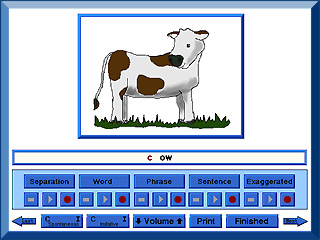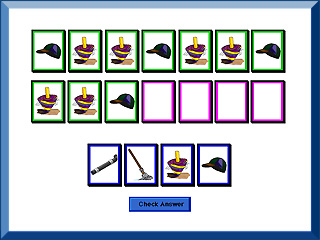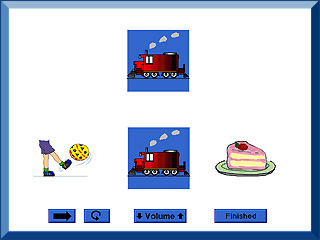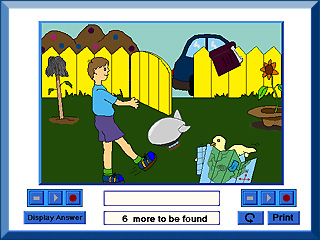Phonology I
Six interactive games that motivate and educate!

Games on this CD.
Six exercises help clients hear the difference between words like “stop” and “top” and say words like “cap” and “spoon”.
Target Audience Appropriate for children ages 3-5 with impaired speech intelligibility.
WN23-1
$5.00
Phonology I
by LocuTour Multimedia
Download now from Gumroad.
Information for Professionals
The flexibility of these game formats helps elicit a large number of productions and provides interesting auditory bombardment sessions. Targeted patterns are: final consonants; initial consonants; initial S clusters; initial L and R clusters; and two and three syllable words. Clients develop receptive and expressive reading readiness skills and improve speech production with the various levels of patterning exercises.
Games on this CD.
Minimal Pairs

Minimal Pairs is an auditory discrimination activity that helps clients discriminate between words that include and do not include their target sound.
The ability to perceive the similarities and differences in words is the receptive activity necessary to develop auditory phonological processing. Receptive processing needs to be consistent and accurate before consistent and accurate expressive production is possible. Auditory processing of minimal pairs establishes an auditory strategy for comparing and contrasting speech at the one-syllable level.
Word Practice

Word Practice provides auditory information at the sound, syllable, phrase, and sentence levels. Clients can imitate or spontaneously produce the stimulus words.
This task is the basis for phonology therapy. It includes the often necessary step of separating the target sound from the rest of the word. In this way, the error sound can be eliminated from the habitual motor sequence.
Word Blending

Word Blending helps clients develop the ability to blend the target sound with the rest of the word by imitating a series of stimuli containing progressively shorter pauses between the target and the rest of the word.
Clients with phonological disorders have often developed strong motor patterns that need to be broken before they can form new, correct patterns. One way to break these old motor habits is to separate the target sound from the rest of the word. This allows clients to produce the target sound without interference from the rest of the word, and the pause breaks the automatic motor sequence. Once they have practiced the target word without the production of the error sound, they are ready to either replace the error sound with the correct one, or add a sound previously omitted in a connected word.
Patterns

Patterns is a versatile game that can be used for auditory bombardment, speech production, and auditory/visual memory.
The use of repeated presentations of words containing the target sounds at a low level of amplification has improved awareness of sound patterns in phonologically impaired children. The use of the Visual Only option (no sound) allows the clinician to make this a speech production task. And, finally, the use of the Fading options turns Patterns into a memory task.
Match Ups!

Match Ups! completes the therapy session with a good game of concentration.
Clients listen to auditory stimuli (more auditory bombardment!) and practice target words using a verbal rehearsal strategy. Hodson and Paden emphasize the importance of the client’s saying the target sound or sequence as correctly as possible to reinforce the correct kinesthetic sensations. Our experience has shown that a multi-sensory approach to establishing placement, auditory perception, and kinesthetic feedback on productions has been the most effective approach to improving phonological processing and speech production.
What’s Wrong?

What’s Wrong answers the question, “And what do we do for carryover?”
This game is designed to be played after the client has become proficient at the sentence level for a target pattern, which includes several target sounds. Clients practice target patterns in spontaneous speech. Each of the 40 scenes has four to seven “wrong” items that are target words. When selected, the word is produced and the client uses the word in a sentence to tell what’s wrong.
